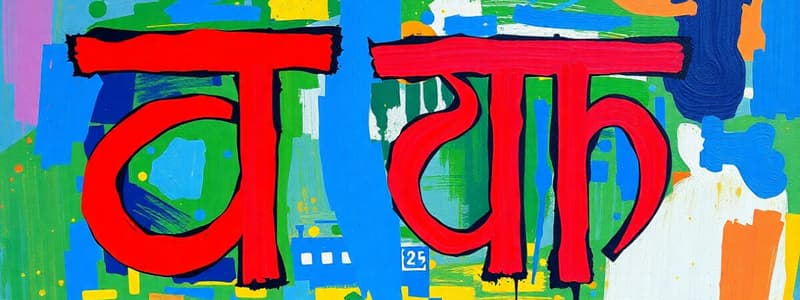Podcast
Questions and Answers
Which of the following statements correctly describes the phonetic structure of Hindi?
Which of the following statements correctly describes the phonetic structure of Hindi?
- The language has 33 consonants which are solely unaspirated.
- Hindi has both short and long vowel sounds, including aspirated consonants. (correct)
- Hindi contains 10 vowel sounds, all of which are aspirated.
- There are no significant variations in the consonant sounds among different dialects.
In the context of Hindi grammar, what is true about the structure of sentences?
In the context of Hindi grammar, what is true about the structure of sentences?
- Verbs are only conjugated based on the subject's number, not tense or mood.
- Gender and plurality play no role in noun forms.
- The typical sentence structure is Subject-Object-Verb (SOV). (correct)
- Sentences generally follow a Verb-Subject-Object format.
What distinguishes the Devanagari script used in Hindi?
What distinguishes the Devanagari script used in Hindi?
- It is the only script used for Hindi and is predominantly written from right to left.
- The script has 44 letters, but only 10 represent vowel sounds.
- Hindi is primarily written in Devanagari, which is formatted left to right. (correct)
- Devanagari script lacks any representation of consonant clusters.
Which statement regarding the vocabulary of Hindi is correct?
Which statement regarding the vocabulary of Hindi is correct?
What is the global presence of Hindi in terms of native speakers?
What is the global presence of Hindi in terms of native speakers?
Flashcards are hidden until you start studying
Study Notes
Overview of Hindi
- Language Family: Indo-Aryan, part of the larger Indo-European family.
- Official Status: One of the 22 scheduled languages of India; recognized as an official language of the Indian government.
Script
- Devanagari: Hindi is predominantly written in the Devanagari script.
- Direction: Written from left to right.
Phonetics
- Vowels: 11 vowel sounds, which can be short or long.
- Consonants: 33 consonants, with aspirated and unaspirated varieties.
Grammar
- Nouns: Gendered (masculine and feminine), with plural forms.
- Verbs: Conjugated according to tense, mood, and subject agreement.
- Sentence Structure: Typically follows Subject-Object-Verb (SOV) order.
Dialects
- Regional Variations: Includes dialects like Bhojpuri, Awadhi, and Maithili.
- Influence: Accents and vocabulary can vary significantly across regions.
Vocabulary
- Origin: Predominantly derived from Sanskrit; also includes loanwords from Persian, Arabic, English, and other languages.
- Common Words: Namaste (greeting), Shukriya (thank you), and Khana (food).
Cultural Significance
- Literature: Rich literary tradition with poetry, novels, and plays; notable authors include Premchand and Harivansh Rai Bachchan.
- Media: Widely used in Bollywood films, music, and television.
Learning Hindi
- Resources: Language courses, online platforms, and language exchange apps.
- Practice: Listening to Hindi music, watching films, and speaking with native speakers enhance learning.
Global Presence
- Speakers: Over 500 million native speakers, making it one of the most spoken languages worldwide.
- Diaspora: Significant Hindi-speaking communities in countries like the USA, UK, Canada, and Mauritius.
Overview of Hindi
- Language belongs to the Indo-Aryan group, a branch of the broader Indo-European language family.
- Recognized as one of India's 22 scheduled languages and holds official status in the Indian government.
Script
- Primarily written in the Devanagari script, which consists of a combination of characters representing vowels and consonants.
- Writing direction is left to right.
Phonetics
- Comprises 11 vowel sounds, with both short and long variations.
- Contains 33 consonants, distinguished between aspirated and unaspirated.
Grammar
- Nouns are categorized as masculine or feminine with corresponding plural forms.
- Verbs are conjugated based on tense, mood, and subject agreement.
- The typical sentence structure follows a Subject-Object-Verb (SOV) order.
Dialects
- Features regional variations including dialects like Bhojpuri, Awadhi, and Maithili, reflecting local linguistic diversity.
- Accents and vocabulary exhibit significant regional differences.
Vocabulary
- Mainly derived from Sanskrit, with additional influence from Persian, Arabic, English, and other languages.
- Common words include greetings and essential terms such as "Namaste" (greeting), "Shukriya" (thank you), and "Khana" (food).
Cultural Significance
- Home to a rich literary tradition comprising poetry, novels, and plays, with notable authors such as Premchand and Harivansh Rai Bachchan.
- Hindi serves as a predominant language in Bollywood films, music, and television, deeply influencing Indian culture.
Learning Hindi
- Available resources include language courses, online platforms, and language exchange applications, enabling effective learning.
- Improving skills can involve engaging with Hindi music, films, and conversing with native speakers.
Global Presence
- Over 500 million native speakers, making Hindi one of the most spoken languages worldwide.
- Significant communities of Hindi speakers exist in countries such as the USA, UK, Canada, and Mauritius, reflecting its global influence.
Studying That Suits You
Use AI to generate personalized quizzes and flashcards to suit your learning preferences.




